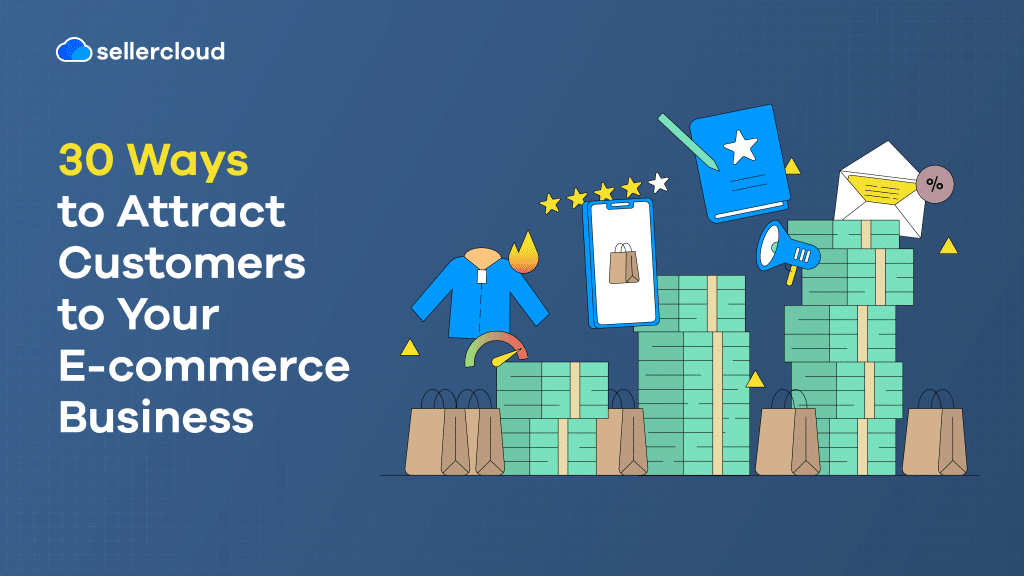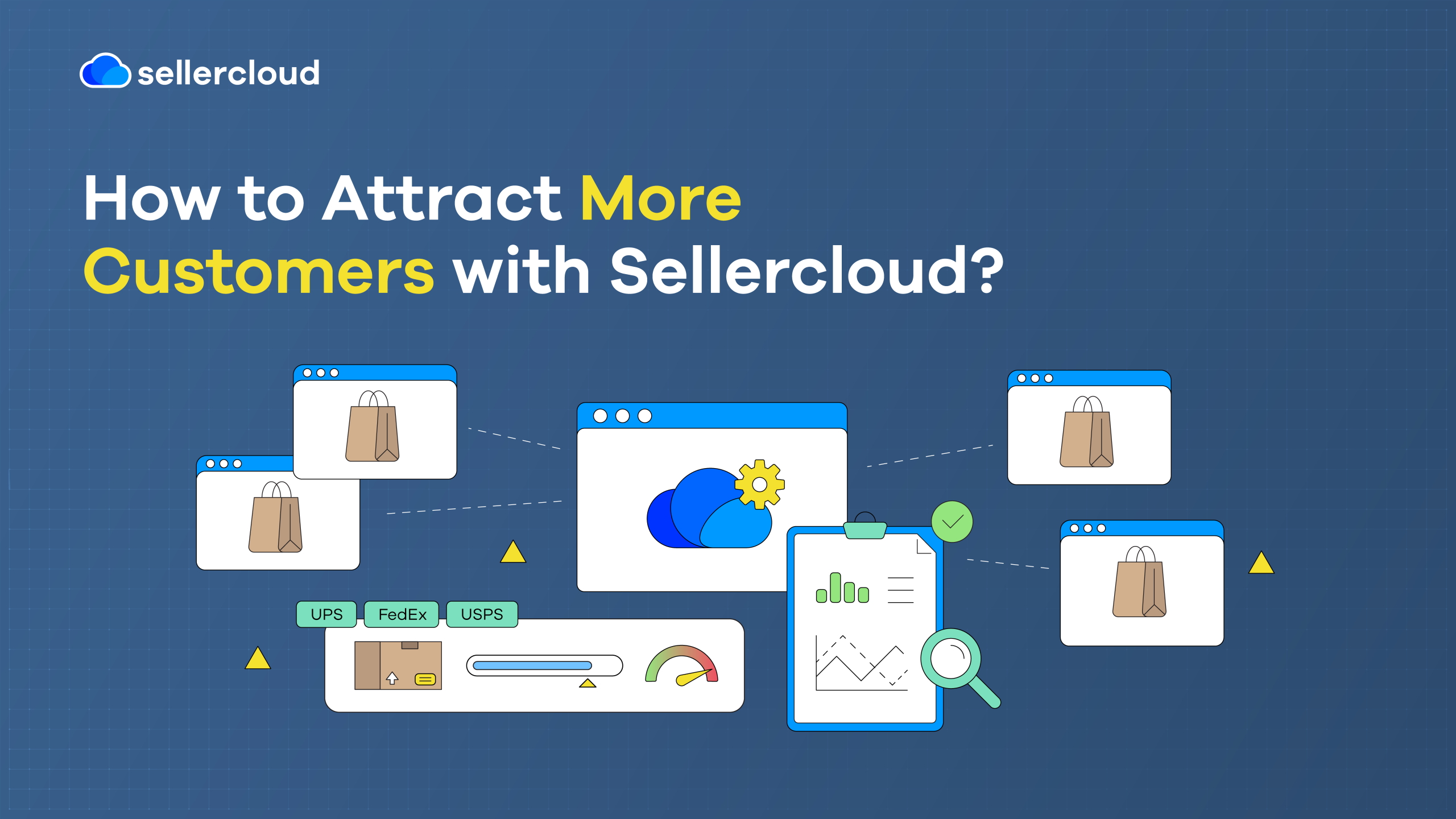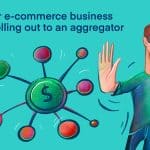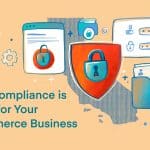
- There are various ways to attract new customers to your business with varying degrees of success.
- Omnichannel selling—where you sell on multiple platforms—is one of the most effective ways to reach new customers. Descartes Sellercloud makes omnichannel selling easier.
As a business owner, you’re probably asking yourself the same few questions: “How can we keep growing?” and “What can we try next to bring in new customers?” The good news is that there are many ways to attract new customers. The bad news is that they can be time-consuming and involve a few risks. So, experimenting with new ways to attract customers must be calculated.
In this article, we will reveal real ways you can attract customers to your business and how Descartes Sellercloud can help you, too.
How to Attract New Customers to Your Business? 30 Methods That Work
Some methods are must-haves, but not all will work for your business. It can depend on the type of ecommerce store you are running and the products you sell. Furthermore, some methods will require more effort than others, and you will likely have to strategize which methods to use—some methods need to come first so you can try others.
Adopting these methods takes time, and managing it all can be hard. For some, it can be nearly impossible to take the necessary steps.
1. Get Your SEO in Order
The No. 1 thing online merchants must do before anything else is to optimize their site for search engines. If you don’t have a good understanding of SEO (Search Engine Optimization), it’s vital that you invest time in learning how it works. It can make or break your online business. The reason SEO is so important is that it’ll impact many of the other ideas on our list.
Firstly, there’s the technical side of SEO. Is everything working appropriately? Have you optimized your website for search engines? Are you meeting Google’s Search Essentials standards? On the content side, you want to ensure you’re ranking for the right keywords on home pages, product listings, and any other content you put on the web.
It’s also worth mentioning that it’s better to aim for white-hat SEO techniques that work in the long run than short-term black-hat techniques (which also require much more work). Furthermore, SEO is not a one-time thing. It must be constantly monitored to ensure your site brings in as much traffic as possible. If you haven’t already, you may need to invest in SEO software.
Don’t forget to target local SEO if you have a brick-and-mortar store.
2. Are You Optimized for Mobile?
Specifically, are you optimized for ‘mobile commerce’, also known as ‘m-commerce’ or ‘mcommerce’? According to data from Statista, in 2023, there are approximately 16.8 billion mobile devices. By 2025, there could be as many as 18.22 billion. (For perspective, the world population is approximately 7.888 billion at the time of writing.) That’s a lot of people that could be purchasing from you right now. And the number of people making m-commerce purchases is expected to grow.
Insider Intelligence says, “We expect retail mcommerce sales to account for 43.4% of total retail ecommerce sales in 2023, up from 41.8% in 2022.” Other estimates suggest that m-commerce already accounts for about half of all sales (if not more), so you could be missing out on many sales.
It’s also worth noting that while many customers buy products on their desktop devices, their decision to buy from your store could start on mobile. They might find your store on their mobile and return to it later on a desktop to make the purchase. So, optimizing for mobile users is also important for desktop sales.
3. Encourage Reviews and Seek Product Testimonials
Positive reviews and testimonials help build trust and credibility in your business and can encourage new customers to purchase from you. According to a Digital Commerce 360 and Bizrate Insights survey, 66% of online apparel shoppers say that reviews are important to them.
Furthermore, according to an article by Simon Byrne of The Bazaar Voice, 88% “of shoppers use reviews to discover and evaluate products.” They may come across a product that fits their needs but may be unsure of the merchant or product quality and check reviews to be sure of the product. They may then decide to purchase the product based on how high or low the reviews are.
When orders are fulfilled, email customers to request reviews. You may need to encourage them to provide a review by offering them the chance to win a prize or a discount on their next purchase. You can create a showcase of the best reviews. Reviews could explain problems the product solved for the customers, ideally relatable issues that other customers can relate to.
Whatever you do, avoid creating fake reviews. If customers can spot it, you will lose their trust and credibility. You can also get caught on platforms like TrustPilot, and it’s a very bad idea. Byrne adds that 56% of shoppers wouldn’t purchase a product if they suspect the reviews are fake, and 81% would avoid using the brand again.
4. Freebies and Samples on the First Purchase
Everyone likes free stuff, whether samples, a small gift, a limited product, or just a voucher code. Customers appreciate it when you go the extra mile. Kevin Urrutia of Voy Media says, “More than 80 percent of consumers say that branded freebies positively impact their overall impression of a brand.”
Not only does this encourage customers to return, but through word of mouth, people will hear about what you are giving away with purchases. Even better, you can advertise what new customers might receive when making their first purchase. However, be careful not to let it get too expensive. Picking, packing, and preparing the order also requires more time.
5. Referral Programs
An article by Steli Efti of Forbes says that referrals are some of the most valuable leads you can get, and it’s true. Referral programs are where you encourage existing customers to refer friends and family by offering discounts or rewards. Efti notes that “60% of marketers say that referral programs generate a high volume of leads” and that “Marketers rate referrals as the 2nd-highest source of quality leads.”
Of course, existing customers are more likely to refer new customers if there is an incentive. For example, ‘Refer three people and get X.’ However, note that many referral programs only reward new customers once they have purchased (not just for registering). Referred customers can refer more customers if the incentive is big enough. Before you know it, you could be pulling in plenty of motivated new customers.
6. Start a Loyalty Program
Like referral programs, loyalty programs can be highly successful at attracting new customers. With a loyalty program, you can reward repeat customers and encourage new ones to return. After three purchases, for example, give the customer a gift or a discount on their next purchase. Larry Dignan of ZDNET revealed that during the pandemic in the first quarter of 2021, Starbucks’ reward program contributed to approximately 50% of US sales. That’s enormously successful.
If you create a loyalty program, ensure it is well-publicized to attract new customers. Word of mouth will also help spread the news. Bear in mind that you will need something to track repeat purchases. Some companies may build apps or create pages the user must log into. Loyalty programs also give you a competitive advantage—new customers are more likely to buy from a merchant that rewards repeat purchases than one that does not.
7. Plan For Seasonal Promotions
Special offers and promotions during holidays and special occasions are popular ways to attract new customers. There are quite a few examples of seasonal promotions:
- Back-to-school.
- Black Friday/Cyber Monday.
- Halloween.
- The holiday season.
- Labor Day.
- Thanksgiving.
- Valentine’s Day.
- Amazon Prime Day.
The list goes on. However, you don’t just have to stick to these holidays. You can center seasonal promotions around any theme or event—there are websites, like Days Of The Year, that list all kinds of obscure celebrations that ecommerce businesses could target. Moreover, you can even make your own. For example, did you know that Amazon Prime Day was invented to celebrate Amazon’s birthday?
Again, you must ensure shoppers know about these promotions, or they may fail to attract as many new customers as possible.
8. Provide Live Support
Whether it be a human or an AI chatbot, quickly responding to customer queries can keep potential customers on your site and help them decide whether to buy a product. This way, you won’t lose potential customers over small things they’re not certain about. New customers don’t know you and are on the fence about buying from you, so a small, helpful gesture can go a long way.
According to statistics from Invesp, live chat software can boost conversion rates between 8% and 20%, and 79% of customers prefer live chat to other methods because it allows them to answer questions quickly. Support can also help new customers navigate your site to what they are looking for and help them through the checkout process, avoiding cart abandonment.
9. Set up a Business Profile on Google
Arguably more of an SEO tactic, setting up a business profile on Google will make it easier for new customers to find your business through Google searches and Google Maps. According to a Gitnux blog post, Google Maps has over 1 billion monthly active users and is the world’s most-used mobile app, used by approximately 54% of global smartphone users.
A Google profile also makes your business appear more legitimate. Plus, they can also differentiate your business from similar businesses or businesses with similar names. In addition, some customers may browse products on your ecommerce site but prefer to buy them in person. They can then easily find your business, see your working hours, and read reviews.
To top it all off, Google’s business profile tool is free to use, making it a no-brainer decision.
10. Build Partnerships and Collaborate with Other Businesses
Partnering and collaborating with other businesses is an opportunity to reach a broader audience that you might be missing out on. You can use partnership events to give away free stuff, like a voucher, to spread awareness of your brand, for example. Alternatively, when customers purchase at your partner’s store, they can be rewarded with a voucher to use at yours—this motivates them to go to your store and buy something.
When you partner up, partners lend credibility to you, and new customers can discover you through your partners. Ideally, it should be a company that reaches the same audience that you want to reach. Partnerships and collaborations should also benefit both parties—they need to gain something from this partnership, not just your company.
11. Offer Limited-Edition, One-Time-Only Products
Limited-edition products can generate excitement and demand, and the product doesn’t always have to be unique. In some cases, it could just be unique packaging. According to an article by YPulse, 43% of 13- to 39-year-olds have purchased special edition or limited-release items from a brand. Furthermore, 31% said they would pay more for limited-edition products.
Limited-edition products should be well-timed. Merchants could offer them in conjunction with a sale or event, for example, or to celebrate something about the company. They should also be ‘cool.’ YPulse also says that 42% of 13 to 39-year-olds have purchased a special edition or limited-release item because it looked cool.
Limited-edition products can also be offered as part of a loyalty program (as mentioned earlier) or given away as a freebie package to new customers.
12. Are You on Social Media Yet?
Social media platforms enable sellers to reach a wider audience and engage with potential customers. It is another vital medium sellers must embrace to stay competitive and increase visibility. Many customers discover new products on social media and seek them out on the seller’s website or a marketplace.
BigCommerce’s 2021 Consumer Spending Trends report found that “Close to half (54.8%) of those surveyed reported finding new products on social media at least once a month.” 40.5% would find it on the retailer’s website, and another 42% would search for the product on a marketplace.
Be careful which social media platforms you choose to work on—your content might be good on one platform but not suitable for another. Likewise, you may need to adapt your content approach in small ways to accommodate the different audiences on those platforms. It’s also highly recommended that you have guidelines to prevent ill-advised posts that might backfire and harm your company’s reputation.
13. Email Marketing Campaigns
Email marketing may seem a bit old-school, but even in the 2020s, it’s highly effective at attracting customers. It can be used to share promotions, new products, personalized offers, and a wide variety of other content you’re producing to engage with customers and hopefully turn them into conversions. The challenge can sometimes be that you need to have content to share, which can take time to assemble.
Furthermore, you must build a mailing list and encourage people to join, which may be hard. It’s important early on to inform potential subscribers what to expect from your emails to set the right expectations.
(Side note: email marketing is also an amazing tool for customer retention. New customers may return multiple times to your store if you get them hooked.)
14. Experiment with Flash Sales
Flash sales are time-sensitive events where you sell goods at greatly reduced prices. Doing this creates a sense of urgency (or ‘FOMO’—Fear Of Missing Out) and can be an effective way to draw in new customers. Time them to happen alongside other events or dates, and also an effective way of offloading excess inventory.
But flash sales are not a perfect strategy (not that many are). They could harm your margins if they are not well-organized. Furthermore, you run the risk of running out of stock, which will upset customers, so you may need more stock than usual. Furthermore, if your brand constantly holds sales, you may lose some credibility in the eyes of some customers.
In the end, flash sales need to be well-planned and well-orchestrated. Don’t just randomly decide one day you will have a flash sale!
15. Put Some Money Down on Paid Advertising
Paid advertising involves bidding to display advertisements, such as banners, to internet users on different sites. The company is charged Pay-Per-Click (PPC) for the most willing to pay. There are many ways to use paid advertising and plenty of platforms—Google Ads, Facebook Ads, and Instagram Ads, to name a few. Deciding which to use can depend on where your audience is active.
You can also experiment with Amazon and other marketplace advertising programs. Before you decide to use paid advertising, ensure you’re shipshape SEO-wise. SEO is much cheaper than paid advertising, and you might be able to reduce the costs of paid advertising by making your site more searchable.
Additionally, it’s extremely important to budget paid advertising properly because it can get very expensive very quickly. So, ensure you understand the costs, set limits, and monitor its success.
It’s also important to have the right expectations in place about paid advertising. According to an article by Oak City Tech, less than 10% of people click on paid ads. Even if someone clicks on an ad, it doesn’t mean they will make a purchase. That said, they may return later, and it is still spreading awareness of your brand.
16. Utilize Blog Content Marketing
Blog content is a highly effective way to attract new customers. According to an article by Yelena Petic of Veza Digital, it can increase leads by 67% and links to your website by 97%. For blog content to be effective, it should be SEO-orientated and provide informative answers to highly searched questions.
This will increase your chance of appearing in search results and demonstrate that you are an expert in your industry. Your blog can also showcase your products, announce new products, and inform readers about promotions. You can also recycle video content and other materials, such as infographics, using blog posts. Furthermore, blog posts can be shared on social media and in a newsletter to increase their usability.
(Another side note: it’s a great practice to utilize content as much as possible on various channels—not just blog posts, but whatever content you produce.)
17. Write Guest Blog Posts on Other Sites
Your blog content doesn’t just have to appear on your website! You can borrow the credibility and authority of others by asking to create guest blog posts on their sites. It can be mutually beneficial for both parties. You can write for your partners about specific industry problems or on niche sites (or at least contact them to write about your products).
Always include valuable links back to your site or wherever you need new customers to go. This is a way to build genuine links across the web. However, before that, ensure that you have thoroughly researched their blog. The last thing you want is your content wasted on a spammy, low-quality website, harming your reputation.
Kinjal Dagli of Wordtune says, “As a general rule of thumb, the sites on your wish list should have a DR [Domain Ranking] of 40 or higher and a spam score lower than 30%.” So, it’s also wise to analyze their site with SEO tools.
18. Reach Out to Influencers and Turn Them into Brand Advocates
Influencers are not just internet personalities who spend too much time on social media. They can be individuals with a wide range of interests who genuinely care about a particular topic. They are usually followed by individuals who share those interests, so by reaching out to them to promote your products, you can reach a sizable audience.
For example, influencers can be well-known individuals on social media, as well as bloggers and YouTube creators. According to a blog post by The Social Shepherd, 61% of consumers trust influencer recommendations (higher than branded social media content, at 38%). Furthermore, 93% of marketers have used influencer marketing.
It’s important to note that businesses should properly vet influencers. You don’t want influencer marketing to backfire by working with someone controversial who can harm your brand.
19. Supply Some Social Proof
In marketing, social proof involves providing evidence of your company’s popularity, such as displaying the number of customers, subscribers, or followers you have. Some companies do this with banners at the top of the site, which can work with live data. Social proof can also include reviews and case studies. It shows that you are established and trusted, and new customers will be less cautious of a company that others trust.
It doesn’t always have to be numbers and statistics. You can get creative with it, for example, McDonald’s “Billions and Billions served.” Social proof only works if many customers buy from you, or it can look a little sad. A small number of buyers could even deter new customers.
20. Try Using Exit-Intent Popups
Exit-intent popups appear when the user is about to leave the site. You have probably seen exit-intent popups on site when you move the mouse erratically, particularly to one side, as if you’re going to click on another tab or close the window. Exit-intent popups have many use cases. They can be used to:
- Offer discounts or incentives to potential customers.
- Keep new customers on the site.
- Avoid cart abandonment.
- Ask them to sign up for your newsletter.
According to an article by OptinMonster, exit-intent popups have a higher conversion rate than other popups, typically converting between 2-4% of website visitors. Remember that exit-intent pop-ups can be frustrating for some customers, so be sure this is something you want to add to your site. (Ensure it’s easy to close the popup, or you may irritate customers.)
21. Feature User-Generated Content (UGC)
Featuring user-generated content, such as photos, videos, and reviews, on your website and social media is a top way to create brand loyalty, which can attract new customers. According to the Adobe Experience Cloud blog, “Being featured on a brand’s website or social media page makes customers feel like they are involved in the brand’s story and deepens their engagement.”
In addition, Adobe also says that “64% of consumers are more likely to post about a brand that re-shares content by its audience.” Another benefit of promoting UGC is that it can be cheaper than working with influencers and appear more authentic. “Users with about 1,000 to 10,000 followers have enough reach to make UGC worth exploring, but are still small enough to maintain trust with new customers,” says Adobe.
22. Dip Your Feet into Video Marketing
Video marketing can explain how to use your products, showcase new features, focus on what your customers most want to know about your product, and tell your brand’s story. The Social Shepherd says 86% of marketing professionals have used video as a marketing tool, and 78% of those professionals felt that video had directly increased their sales.
Don’t forget that videos can be utilized in blog posts and shared on social media to maximize viewership. Also, it’s okay to have both video and written content on the same topic—this way, you can ensure you’re getting customers with both preferences. Some prefer to read, while others prefer to watch a video.
23. Set Up Abandoned Cart Emails
Abandoned cart emails are hugely successful at encouraging customers to return to your ecommerce site after adding products to a cart but then leaving the site without buying them. Abandoned cart emails are typically sent automatically to customers when they close the browser with items in their cart and ask them to return to the store. It’s your chance to turn a missed customer into a fulfilled customer.
BigCommerce says, “Ecommerce brands lose $18 billion in yearly sales revenue to cart abandonment” and “Cart abandonment emails have a 41.18% open rate — far outperforming the typical marketing email at 21%.”
24. Get Back in Contact with Old Customers
Yes, we know this is an article about encouraging ‘new’ customers! But did you know that returning customers will spend more at your ecommerce store than new customers? As much as 65% of a company’s purchases can come from returning customers, according to a Business News Daily article. Plus, old customers are also easier to contact if you already have their details.
Old customers can be an untapped goldmine for some businesses. However, you must ensure you comply with any data laws, such as California’s CCPA and the EU’s GDPR, if you sell to customers in Europe. You don’t want to contact customers whose data you should no longer have accidentally.
25. Run a Social Media Contest
Again, people love free stuff! Social media contests are a top way to gain new online followers, who could then convert into customers. A common social media content format that requires very little effort is encouraging users to ‘like, comment, and share’ one of your posts. All you need is a prize that your audience would be interested in.
What is also highly effective about this strategy is that as more people interact with your brand, your business will be exposed to more and more people. Potential customers will see people they follow interacting with your brand, whether liking, sharing, or commenting on your post.
There are various other types of social media contests you can hold, such as video and photo contests. Just be sure to offer a genuinely worthwhile reward.
26. Host Virtual Events
Virtual events have become more common since the pandemic, and people are more used to them. They can exist in various formats, such as webinars, virtual product launches, and even Q&A sessions, and are a great way to engage with potential customers.
A benefit of holding virtual events is that they can be recorded, and people can watch them again later. If someone misses the event, that’s not the end of the world—they can still watch it later at a more convenient time. Furthermore, virtual events can reach customers further away from your store and across borders.
Check out Descartes Sellercloud’s webinars if you’re looking for some great examples.
27. Hold In-Person Events
You don’t only exist on the internet! Just like hosting virtual events, this is a chance to meet up with your customers, and for some, it may feel a lot more authentic and personal. However, in-person events may require more effort to find a location and may cost you more to host, but if done right, customers may find it more engaging than a virtual event.
According to an article by NoBlue, a hybrid version is emerging that incorporates both virtual and in-person events to get the best of both worlds. However, they also say that networking is better in person, as are trade shows, exhibitions, and guest panels (as people can talk over each other in virtual versions).
So, while in-person events may have a slight edge, that doesn’t mean you should rule out virtual events.
28. Embrace Gamification
Gamification is where you bring elements of gameplay into other kinds of activities. In this case, online shopping. Gamification can be used in ecommerce in a number of creative ways, and it can be a highly engaging way to attract new customers. Studies have shown that gamification can enhance user experience and motivate people to complete a process. Some even suggest that mundane tasks become easier to complete with gamification elements.
Introducing gamification could mean something simple like rewarding customers with badges or points to enhance the shopping experience or inviting them to quizzes or games where you build or design something. It’s worth mentioning that gamification may not be appropriate for every brand. It may appeal more to younger audiences (but that might be exactly what you want to do).
In addition, more advanced experiences can be more costly and take more time to create. However, one thing is for sure: your brand won’t be forgotten quickly.
29. Personalize Your Offerings
Personalization is a huge topic in ecommerce, and it can mean a lot more than just using the customer’s name in an email (though that can also boost engagement). Personalization is best used to provide potential customers with product recommendations and offers based on their behavior.
This can also include offering customers kits that package products the customer has shown an interest in. McKinsey’s Next in Personalization 2021 Report revealed that 78% of customers would choose, recommend, and repurchase from a brand that offers personalization.
However, personalization can be tricky to perfect for new customers, and it is best utilized for return customers. This is because it’s hard to narrow down what a customer might like when visiting your store for the first time (unless you outright ask them).
Regarding new customers, you can only make assumptions based on what other customers have bought or suggest other items that the customer looked at while browsing your store, which can be limiting.
30. Build a Community Around Your Products and Industry with a Forum
A forum is an excellent way to create a space where customers can discuss topics related to your products and the industry you sell in. This can also be a useful place to hear what customers want, make announcements, and get instant feedback.
More importantly, new customers can browse forum discussions, learn about your products from other customers, and even ask questions themselves. Of course, though, you must moderate such a space. Leaving it unmoderated could harm your reputation by scaring away customers.
You also want to prevent bots and people with malicious intent who might want to harm your brand. Take inspiration from platforms like Reddit, Quora, and Discord, but also be sure to check out Microsoft Docs, IGN Boards, and TripAdvisor Forums, which companies put together to increase customer engagement.
How to Attract More Customers with Descartes Sellercloud?

The best way to attract more customers is to sell where they shop! Don’t just sell on the top marketplaces like Amazon and eBay. You can sell on multiple platforms. This is called ‘omnichannel’ selling. Omnichannel selling increases your marketplace visibility. Customers can be habitual in where they shop, which can cut them off from sellers in other marketplaces—you need to go to them.
It can be hard, though. Dealing with sales, fees, and inventory on several platforms can easily become overwhelming and lead to many challenges. This is where Descartes Sellercloud helps. Descartes Sellercloud enables merchants to centralize their sales across multiple marketplaces, providing unrivaled visibility into their operations.
Plus, with versatile integrations like Zapier, Make.com, and Pipedream, sellers can manage email marketing campaigns and other content to increase their reach. No need to switch accounts. Deal with inventory in one space. Deal with couriers in one space. Deal with customers and returns, reports, and analytics all from one space, no matter how many platforms you sell on.
Book a Descartes Sellercloud demo today.
Key Points
You now have 31 (30 + Descartes Sellercloud) new ways to bring new customers to your business. Remember these key points.
- First, it is vital to ensure your site is optimized for search engines, especially before you decide to pay for advertising.
- Not all of the strategies we have listed will work for your site—you should also be aware of the risks associated with some of them. You don’t want them to backfire and harm your business.
- Many strategies involve creating events and content, building partnerships, and utilizing new mediums to reach new audiences.
- While drawing in new customers is important for growth, remember that returning customers will spend more at your store over time—remember to encourage them to shop with you again.
- One of the best ways to reach new customers is through omnichannel selling, which involves selling on multiple platforms. Descartes Sellercloud makes this easier by centralizing everything you need.




